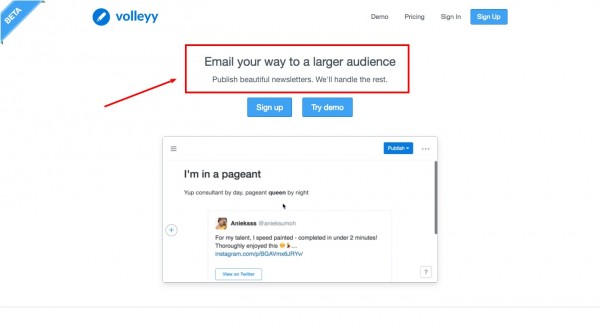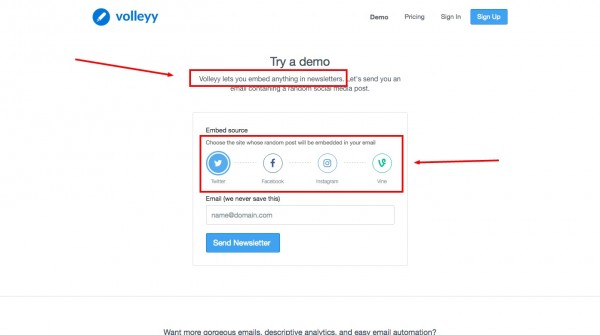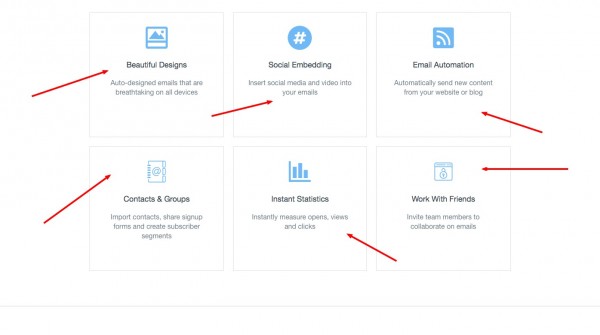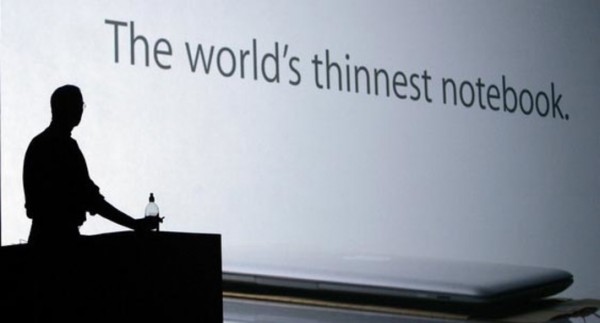
Today I’m looking at Noddy’s website volleyy.com. He’s got a service helping people “publish beautiful newsletters”. Let’s dive in and see what we can learn to help us in our own marketing adventures…

Positioning is everything.
OK, I’m on the homepage and I’m greeted with a headline and an animated gif:
Email your way to a larger audience.
Publish beautiful newsletters. We’ll take care of the rest.
Other than two words “publish, newsletters” this headline isn’t doing much to position the product at all. It won’t grab the customer. It doesn’t solve a problem. It doesn’t really say how this product is different from the established competition.
The first line, “Email your way to a larger audience” is what I’d call “clever or cute”. But what does it actually mean? As someone who has multiple, quite large email lists, it doesn’t resonate with me in any way.
It just sounds like “sales talk” and great sales talk doesn’t actually sound like sales talk, it sounds like a solution to a big problem. 🙂
“Publish beautiful newsletters” sounds straight out of the Apple playbook. What is beautiful about these newsletters? If I lined these newsletters up alongside half a dozen of the newsletters I receive from companies who use Mailchimp, would they in any way stand out as being more beautiful?
“We’ll take care of the rest.” What exactly is “the rest?” If the rest is a problem that the customer has to deal with, you need to clearly state what that problem is.
These couple of lines are the most important in your entire business, they are your sales pitch concentrated down into just a spoonful of juicy goodness. So we need to work on every word until they are the foundation of a product that has real value to lots of people. There’s no room for cuteness, cleverness or irrelevance.
Action: Take your opening positioning statement super seriously. It’s the foundation of your business. It’s a sales pitch condensed into just a few words. It’s the reason why anyone should care about your product and invest more time. It’s the reason you’ll make a profit, or go out of business. Everything else is an expansion on that opening promise.

Forget what you made, how is it valuable?
Digging deeper into the site we have a demo page. Now, the demo page seems to make it clearer what the value of this product really is.
From what I can tell, it’s the ability to embed social media posts in an email.
Noddy already shows that on the home page. There’s an animated gif showing the embedding of a tweet in an email. But because it’s presented in the context of a fuzzy, unclear headline, it doesn’t make sense.
Every step has to make sense. A user who doesn’t understand step 1 rarely moves to step 2. They hit the back button. If a user lands on your home page and doesn’t understand your headline (step 1), they may pause for a couple of seconds to try and understand the animated gif (step 2). But if they don’t “get it” by then, the number who will click the demo button to learn more is tiny.
Back to the demo page. The product is explained as:
Volleyy lets you embed anything in newsletters.
OK, “anything” sounds a bit generic, but as I can see the various social media icons, I’m starting to understand. NOW, the animated gif from the HOME PAGE starts to make sense. Now I’m starting to at least see the potential value in this. Maybe this is something that Volleyy can do, that my existing email provider can’t do.
Only after I understand what it is, can I decide if it’s really valuable to me.
We have to get this right first. We have to know how and why we are valuable to our customers. We have to understand the real problem that we solve.
At this stage, I’d suggest replacing that home page header with something like:
Volleyy lets you embed social media posts in your newsletters.
Action: Combine the demo page and home page. Say exactly what the unique value of your service is, in the same place as showing that value, and allowing them to demo it, all in one smoothly flowing sequence. 1, 2, 3.

Who is our customer, what’s the human context for this tool?
Now we’ve established what the real value of the product is…(and I’m only guessing at that from the information available, but I hope my guess demonstrates the principles)…we need to think about who would use this tool, and what the context of that use is. This will help us think from the customer’s perspective as a user. And get out of our own heads as developers and marketers etc.
For the customer to understand our product, we have to see it from their perspective.
That really means getting honest about who would actually use this tool?
There are several pressing problems when building email lists. Building your list in the first place is mostly about what you do elsewhere. How much you hustle and promote your list in other places.
By far, the biggest barrier to list building is the mindset and skill required to not only create, but publish quality content. Very few people have those skills.
After that, getting your emails delivered (not marked as spam) and opened (good headlines) are the biggest real-world problems.
Volleyy does make it easier to “create” and “publish” content, because it’s reusing other forms of content that are quick and easy to create. Tweets, photos and videos etc.
But that’s also potentially a low-value circle jerk. The demo shows someone emailing a tweet about an instagram post.

The reason Twitter and Instagram exist in the first place, is because email isn’t suitable for an endless stream of relatively low-value posts like one-sentence tweets and pics.
What that really means is, very few people are going to build successful email lists when all they post are tweets and Instagram pics.
Volleyy may find ten million people who create tiny email lists, and bug their friends with emailed social media posts. But the question is – how many customers will ever build lists big enough to fall into the PAYING category?
Let’s presume there IS some market for this. Let’s presume there’s a need for emailed tweets, that my brain is too old and addled to understand. (Entirely possible). In that case, we have to clearly identify who that person is, what their lifestyle is, what their BUSINESS is. HOW and WHY they would build a large list based on emailing social media posts.
One group of people that may see the value in emailing social media posts, are “celebrities”. If you’re a Taylor Swift or Justin Bieber fan maybe you don’t mind getting an email a day, to ensure that you didn’t miss out on that killer instagram pic that will add meaning and purpose to your day.
So, maybe Volleyy could target this as a tool for people who are building a fan base, in the music, art, modelling, acting or fitness world. A world where people are creating a LOT of social media content. All day long, on multiple channels, mostly from their phones. And where the ability to quickly send out an email based on their best social media post of the day, via their phone, may be a real benefit to them.
If we focused on this market, we now have a bunch of people we can SHOW in our marketing. Attractive, talented, creative people. We now have a world we can tap into. We now have a community we can target. Our “app” is becoming more human.
And instead of trying to stir up interest from the general masses, we can target the cream of the social media creators. The young and talented, those “on the rise” on each of the social media platforms.
How might we change that positioning headline, now we have a specific market?…
Volleyy lets you email your best social media posts to your fans, quickly and easily from your phone.
That would need some refining, I’m doing this on the fly, but we now have a complete story. A story in which your product solves a specific problem for a specific type of person, in a specific context.
Imagine the promotional video you could create. Up and coming musician/model/actor who takes 30 snaps/pics/tweets a day, emailing the ONE that got the most attention, via email, on their phone, in just a few clicks to their email list.
Action: If your threshold for getting paid is people with a list of 2000 email followers, you need to target people who have any chance of building a list of 2000 people and who want to receive the type of email your product is designed to create. Narrow the market, pick a niche, then you can incorporate the human aspect into the technical solution. Selling is about people.

The problem with feature boxes.
There’s nothing wrong with making a list of features in the planning stage. Then working out what the real benefit of those features is.
You may discover that you magically have 6 really important features / benefits that conveniently fit those 6 iconed boxes. But it’s unlikely.
Which means, if you’re using a 6-box feature panel, you’re not prioritizing benefits in order of importance to the customer. If you can achieve just one thing that’s genuinely helpful and different than your competitors you’re winning. If you can do two, you’ll kill it.
In this case, maybe the number one thing is that you can embed social media posts. And maybe the second thing is that you can do that really quickly and easily (as few keystrokes as possible) from a mobile phone? If the real value of this product is something else, it hasn’t been demonstrated convincingly yet.
Action: There are formulas, rules and patterns to marketing. But it isn’t painting by numbers. Don’t just fill in the blanks on templates because they exist. Or copy what everyone else is doing. When it comes to the features and benefits of your product highlight what’s really important to your customers in depth, and downgrade the rest.

Only compare things that the customer really cares about.
Everyone loves a 3-column comparison table where you have all the big green ticks and your competition is trailing woefully behind. That stuff is cool if you’re selling a commodity and any additional feature adds value. But that’s not the profitable end of the pool.
If you do try to go head-to-head in a comparison, you have to do so with features that people really care about. If you don’t, you’ll damage your pitch by insulting their intelligence.
Is “Automatic email theming” really at the top of anyone’s Christmas list? Is “building without drag and drop”? And comparing Yahoo and Gmail to Mailchimp seems like comparing apples to spaceships.
The goal is not to have the longest list of ticks. It’s to have one or two ticks that one group of people really values.
Action: Do a side-by-side comparison demonstration of something real and valuable. Let’s imagine that one of your users can email an Instagram post to their list in 10 keystrokes and in less than 30 seconds on their mobile phone with your service, compared to the 25 keystrokes and 90 seconds it takes on your competitor’s site. Demonstrate that in a side-by-side video. SHOW THEM how you lead in something valuable.

A gorgeous word about Apple.
Every generation is influenced by the big marketing successes of the time. Which is why it’s useful to learn marketing from a historical perspective. We are the generation brainwashed by Apple.
“Publish beautiful newsletters…want more gorgeous emails?…”
But adjectives like gorgeous, beautiful, captivating etc. are not the reason Apple became Apple. They are the cherry on top of real problem-solving solutions. The “1000 songs in your pocket” iPod may be gorgeous. The “Internet in your pocket” iPhone may be beautiful. The “lightest laptop in the world” MacbookAir may have been captivating. But they were all real solutions to real problems, first and foremost.
Action: You should always know what that real problem is that you’re solving, first and foremost. Beautiful adjectives are just garnish, best not used until the main dish has been thoroughly practiced and mastered.
[userpro_private]
Names are really important.
Especially for low-value products that require a high volume of people (lots of word of mouth).
Volleyy is something of a word puzzle. People don’t remember word puzzles.
The number one purpose of a name, is to help customers remember you. For people to remember the name Volleyy they have to remember something like “it’s called volley, like volleyball, but with two y’s.”
And once you change the spelling of any word, it also makes it harder to remember how the word is spelled in the first place, so people will be asking themselves if there is one ‘l’ or two ‘ll’s’ in volley.
So, the mental conversation that has to happen to remember your name is “it’s called volley, like volleyball, it’s an email thing, it has two ll’s and two y’s. vo-ll-e-yy.”
That’s requires too much brain power. People won’t remember it, so they won’t refer you to their friends.
Action: Consider a simpler name. Minimal syllables. Relevance plus some kind of novel image that’s easy to picture. “Mailchimp” is a superb example.
[/userpro_private]
Summary.
The big question behind any successful product is “who is my customer and what problem are they so motivated to solve that they will pay for my solution”? Finding and highlighting what motivates them is key.
As developers and engineers, we often start with a technical feature or tool, which can be fine. A lot of extremely valuable solutions started off as accidents or experiments looking for a problem to solve.
But once we have a solution, we still have to find the right audience for it. The right people. And we need to speak their language. Before our tool becomes a profitable product.
At every stage we have to really dig deep and ask…beyond the technical solution we have created, what is the unique problem we’re solving for other people here? And do they really value that solution enough to pay for it?
I want to thank Noddy for sharing his work and helping everyone learn from the process, I really respect what he’s doing. Until next time, stay the course, see it through, make your mark!
Paul.